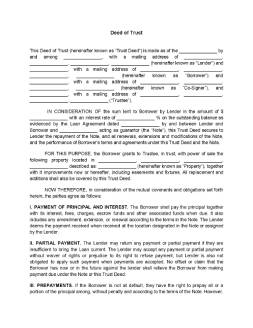- Eviction Notice Forms
- Power of Attorney Forms Forms
- Bill of Sale (Purchase Agreement) Forms
- Lease Agreement Forms
- Rental Application Forms
- Living Will Forms Forms
- Recommendation Letters Forms
- Resignation Letters Forms
- Release of Liability Agreement Forms
- Promissory Note Forms
- LLC Operating Agreement Forms
- Deed of Sale Forms
- Consent Form Forms
- Support Affidavit Forms
- Paternity Affidavit Forms
- Marital Affidavit Forms
- Financial Affidavit Forms
- Residential Affidavit Forms
- Affidavit of Identity Forms
- Affidavit of Title Forms
- Employment Affidavit Forms
- Affidavit of Loss Forms
- Gift Affidavit Forms
- Small Estate Affidavit Forms
- Service Affidavit Forms
- Heirship Affidavit Forms
- Survivorship Affidavit Forms
- Desistance Affidavit Forms
- Discrepancy Affidavit Forms
- Guardianship Affidavit Forms
- Undertaking Affidavit Forms
- General Affidavit Forms
- Affidavit of Death Forms
Deed of Trust
The protection that a stable house provides is a basic human right and need. This reason, among others, might be the most potent rationale why people are willing to apply for long term loans and promise their other properties as collateral. Engaging in a long-term agreement similar to this warrants a formal document that will protect both parties from possible breaches. The formal document that perfectly captures the essence of the agreement and breaks down its conditions is a deed of trust. Continue reading this article to know more about its role and importance. Read More
What Is a Deed of Trust?
For those who are acquainted with loans, the terms mortgage deed and deed of trust are often used interchangeably. But, it should not be the case because there is a distinct difference between the two even if they have a similar purpose. A deed of trust is a secured real estate investment that bases on the loan agreement between the lender and borrower. Similar to a mortgage deed, it also documents the property used as collateral to ensure the compliance of the borrower. An added factor for a deed of trust document is the third-party trustee. In this set-up, the trustee becomes the temporary owner of the property. The terms and conditions that free the arrangement from problems are present in a deed of trust.
How Do You Create a Deed of Trust?
There are a handful of conditions, situations, and elements to consider when creating a deed of trust. From the nature of the signed loan agreement up to the specifics of the rights of the trustee, the conditions must be written specifically to avoid confusion and possible validity questions. If you plan to borrow from sources other than banks, make sure that you are well-acquainted with the format and elements of a deed of trust form.
1. Introduce the Parties
Introducing and presenting the details of the parties is especially important for a deed of trust document because there are several parties involved. Aside from the usual lender and borrower, the deed also requires the details of the trustee and co-signer. The co-signer pertains to the same party in the loan agreement if ever there was one. Even if the document calls for several parties, it only needs the legal names and mailing addresses. The legal name is especially critical for parties that are organizations or firms. In most cases, only the lender is an organization or firm.
2. Describe the Loan and Property
Expectedly, the details of the loan agreement between the lender and borrower must be present in the deed of trust form. This agreement serves as the foundation of the deed. But, it does not require all the details of the loan, not even a summary. It only requires the principal amount, interest rate, and signing date. Aside from the nature of the loan, this particular stipulation also demands details of the security property or collateral. Similar to what was required for introducing the parties, the property’s exact address is required together with its legal description.
3. Explain the Payment Arrangement
All the parties involved must be well-informed about the terms of the payment scheme. The borrower, as well as the trustee, must know the amount that they will be paying every month and when to pay it. Sometimes, the method of paying is as important too. Using other methods of payment, aside from what it preferred, can tamper with the validity of the payment. There are several other terms in the document that affects the borrower’s payable amount such as insurance and maintenance fees among others.
4. Set the Parameters of the Trustee’s Power
The trustee plays an important role in protecting the property. Thus, all the parties must be well aware of what the trustee is capable of. In most states, the trustee has complete ownership of the property but the borrower has the sole right to reside in it. On the flip side, the dictate in other states only allows the trustee to hold a lien over the property. In more important matters, the power of the trustee to foreclose the property must also be emphasized.
5. Indicate the Consequences of Default
The presence of the collateral and the trustee is meant to ensure the borrower to pay accordingly. However, the borrower may still commit a default, which is non-payment, or other violations of the contract’s terms. If these situations happen, the parties can review this deed of trust to see the appropriate consequence. It is essential that this deed of trust must contain the specifics of the consequences such as foreclosure and acceleration of payment. But if the borrower was faithful in paying out the loan, the document must also present the details regarding the release of the property.
Frequently Asked Questions
What is the difference between a mortgage and a deed of trust?
The confusion between a mortgage and a deed of sale is not something new. As a matter of fact, both documents share a number of similar stipulations. The primary difference between the two is the number of parties involved. A mortgage only has two participating parties. A deed of sale, on the other hand, requires three parties—lender, borrower, and trustee.
Is the property’s title its deed of trust?
Even if there are people who use these two terms interchangeably, these documents are completely distinct from each other. A title refers to the legal ownership of a certain property. A deed of trust, however, holds the property and its ownership as collateral or security instrument.
Who holds the legal title in a deed of trust?
The arrangement represented in a deed of trust requires a piece of property and its ownership as a security instrument until the loan is paid off. In the meantime, the trustee holds the legal title of the property.
What is the primary purpose of a deed of trust?
Similar to other contracts and agreements, the purpose of a deed of trust is to provide protection and security. In particular, a deed of trust protects the property set as collateral in cases of disputes or breaches.
Do deeds of trust expire?
There are two ways on how a deed of trust will expire. The first and obvious reason is when the deed reaches its maturity date. The other reason for its expiration is when it reaches 35 years after its execution.
Loans, mortgages, and deeds of trust are easily available options that make homeownership affordable and available to a greater population. However, individuals must be wary of their terms and conditions because it involves a significant amount of money. To save you from troubles later on, make sure that you are well-acquainted with these documents even before using one.

